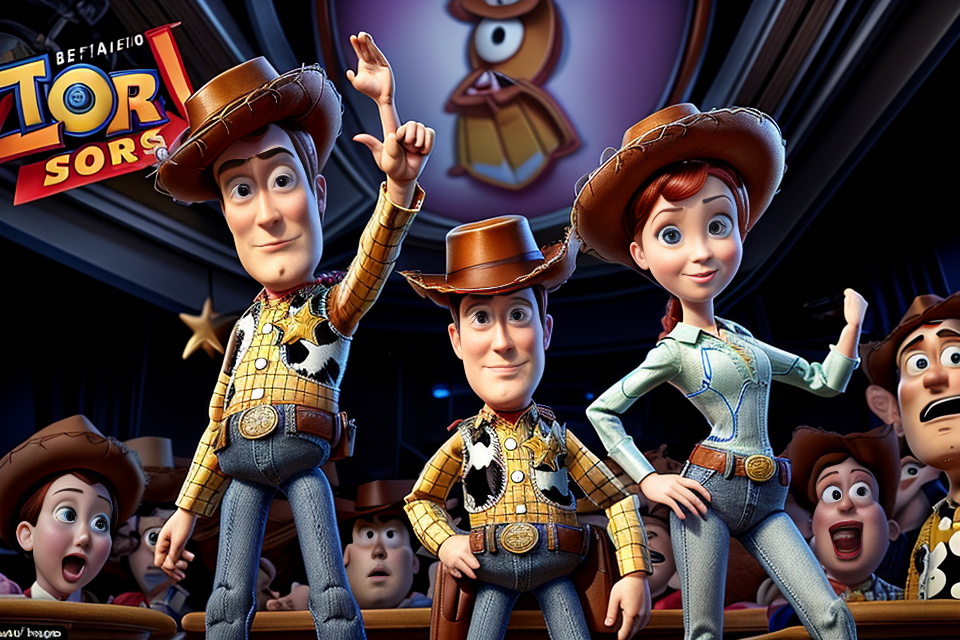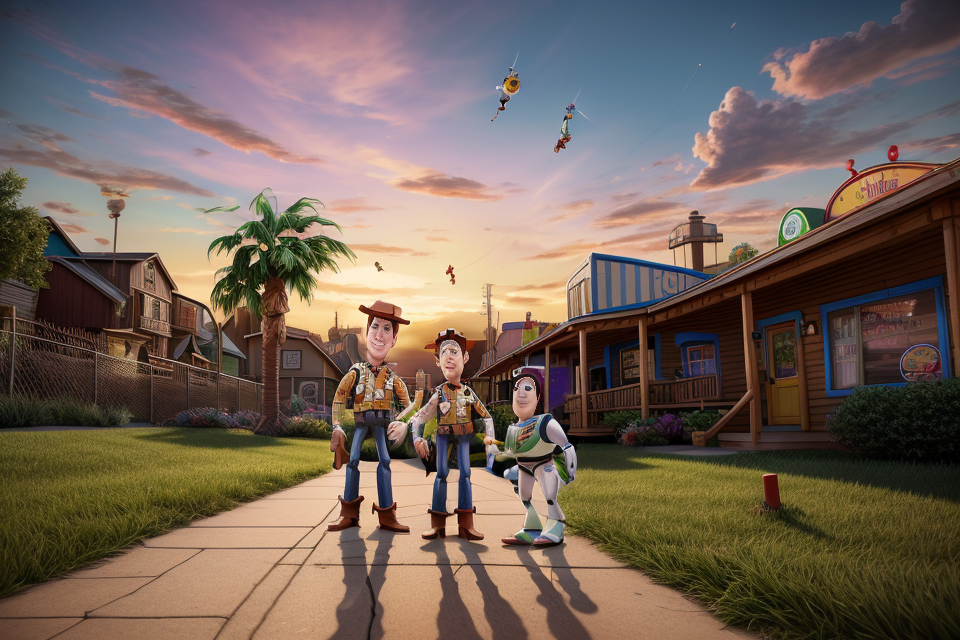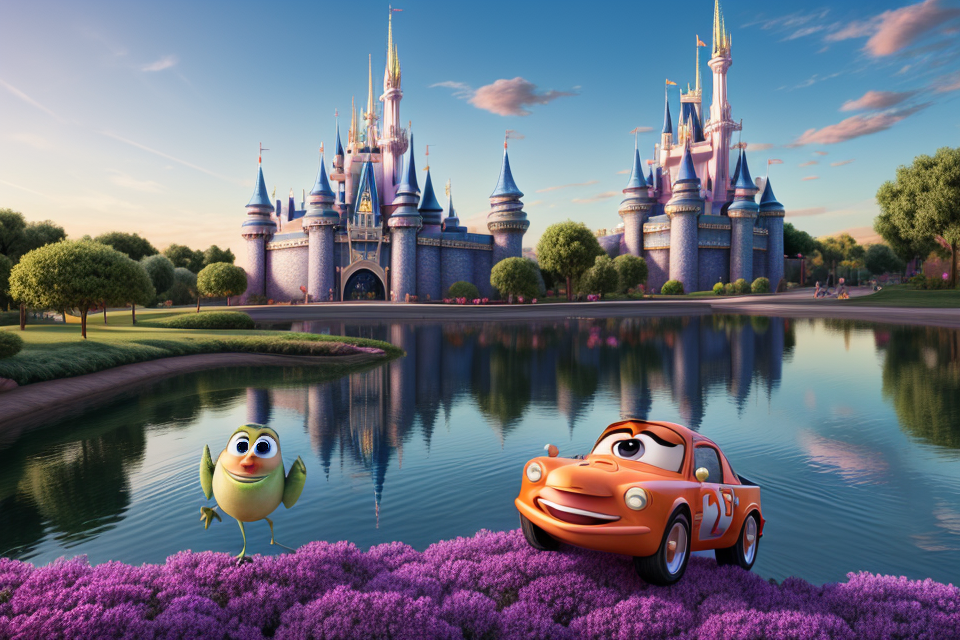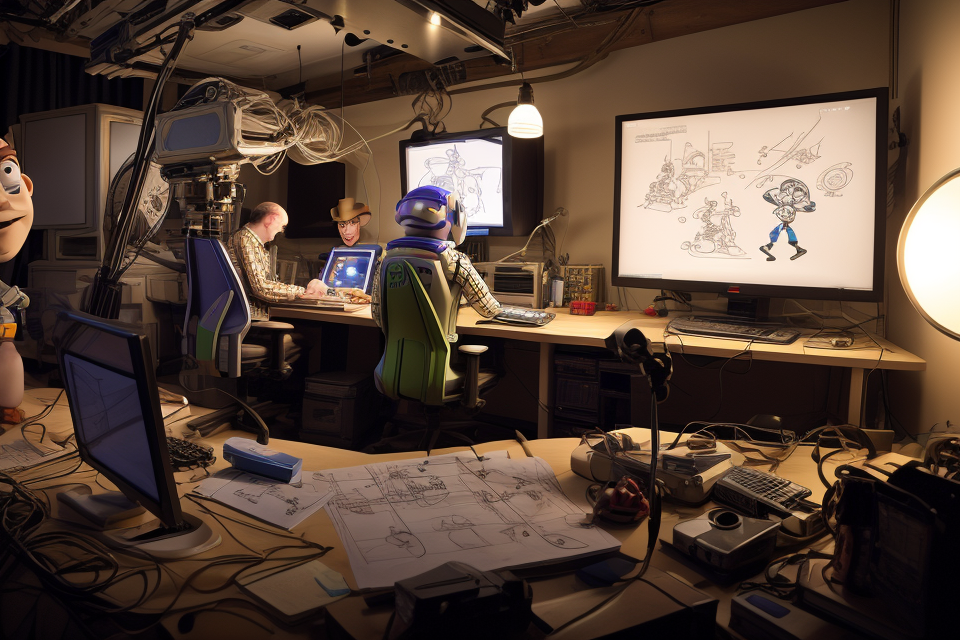
Ah, the age-old question: who owns Toy Story? It’s a debate that’s been raging on for years, with fans and movie buffs alike all having their own opinions on the matter. Some say it’s Disney, while others swear it’s Pixar. But who’s right? Well, the truth is a little bit of both. You see, Toy Story is a joint production between Disney and Pixar, with both studios having a hand in its creation and ownership. But the real question is, just how much ownership do they each have? That’s what we’re here to find out. So, let’s dive into the fascinating world of Toy Story and explore the ownership tussle between Disney and Pixar.
The Creation of Toy Story
The Collaboration Between Pixar and Disney
In 1991, Pixar and Disney formed a partnership to produce Toy Story, the first fully computer-animated feature film. This collaboration was a turning point in the history of animation, and it marked the beginning of a long and complex relationship between the two companies.
To understand the significance of this collaboration, it is important to note that Pixar was a small, independent animation studio at the time, while Disney was a well-established leader in the animation industry. Despite their differences in size and experience, the two companies shared a common goal: to create a groundbreaking animated film that would capture the hearts of audiences around the world.
The collaboration between Pixar and Disney was a true partnership in every sense of the word. Both companies contributed resources, expertise, and creative talent to the project. Pixar provided the animation technology and software, while Disney brought its experience in storytelling and character development.
The collaboration was not without its challenges, however. There were disagreements over creative control and ownership rights, and there were times when it seemed as though the project might not succeed. But despite these obstacles, the two companies persevered, and in 1995, Toy Story was released to critical acclaim and box office success.
The success of Toy Story was a testament to the power of collaboration between companies with different strengths and expertise. It demonstrated that by working together, even the most unlikely partners could achieve something truly remarkable. And it set the stage for a long and fruitful partnership between Pixar and Disney that would continue for many years to come.
The Involvement of John Lasseter
John Lasseter, a renowned animator and filmmaker, played a pivotal role in the creation of Toy Story. He served as the director of the film and was instrumental in bringing the project to life. Lasseter’s passion for animation and his vision for the film’s characters and story helped to shape the final product.
One of Lasseter’s main contributions to Toy Story was his insistence on creating believable and relatable characters. He believed that audiences would connect with the characters if they were more human-like and less cartoonish. This approach was a departure from the traditional animation style of the time, which often featured exaggerated and over-the-top characters.
Lasseter also played a key role in developing the film’s groundbreaking computer animation technology. He worked closely with the technical team at Pixar to ensure that the characters and environments in the film were rendered in a way that was both visually stunning and emotionally engaging.
In addition to his creative contributions, Lasseter was also instrumental in building the teamwork and collaboration that would become hallmarks of the Pixar culture. He encouraged the artists and animators at the studio to work together and share their ideas, resulting in a collaborative and supportive environment that fostered innovation and creativity.
Overall, Lasseter’s involvement in the creation of Toy Story was crucial to the film’s success. His passion, vision, and leadership helped to shape a new era of animation and established Pixar as a major player in the film industry.
The Merger of Pixar and Disney
The Impact on Toy Story Franchise
The Ownership Dispute
The ownership dispute over the Toy Story franchise began when Pixar and Disney merged in 2006. While the terms of the merger were generally favorable for both parties, the issue of ownership over the intellectual property rights of Toy Story proved to be a point of contention.
Legal Battle
The disagreement over ownership led to a legal battle between Pixar and Disney. The two companies engaged in a bitter dispute over the rights to the Toy Story franchise, with each side claiming that they had the right to control the future of the series.
The Role of Copyright Law
The ownership dispute hinged on the interpretation of copyright law. Under copyright law, the creators of a work typically retain the rights to the intellectual property. However, in the case of Pixar and Disney, the question was whether the Toy Story franchise could be considered a joint work, with both companies having an equal claim to the rights.
The Court’s Decision
The legal battle over the ownership of Toy Story lasted for several years. In 2013, a federal court ruled that Disney had acquired the rights to the Toy Story franchise through its acquisition of Pixar. The court found that the copyright to the Toy Story films belonged solely to Disney, and that Pixar had no claim to the rights.
The Impact on the Toy Story Franchise
The resolution of the ownership dispute had a significant impact on the Toy Story franchise. With Disney holding the rights to the intellectual property, the company was able to continue producing new films in the series, as well as expanding the franchise through merchandise and other media.
On the other hand, Pixar was left without a claim to the rights of the Toy Story franchise, and was unable to continue producing new films in the series. The resolution of the ownership dispute effectively marked the end of Pixar’s involvement in the Toy Story franchise, and cemented Disney’s control over the series.
The Future of Pixar Animation Studios
After the merger between Pixar and Disney, Pixar Animation Studios continued to operate as a separate entity from Disney Animation. This allowed Pixar to maintain its unique style and approach to animation, while also benefiting from the resources and support of Disney.
Under the leadership of John Lasseter, Pixar continued to produce critically acclaimed and commercially successful films. The company also began to expand its portfolio, exploring new territory with films like “Cars” and “The Incredibles”.
One of the most significant developments in the future of Pixar Animation Studios was the launch of Pixar Animation Studios Canada, which was established in 2004. This facility, located in Toronto, allowed Pixar to expand its production capabilities and increase its output of animated films.
Another key development was the acquisition of Lucasfilm by Disney in 2012, which brought the “Star Wars” franchise under the Disney umbrella. This led to the development of a number of new “Star Wars” films, including “Rogue One: A Star Wars Story” and “The Force Awakens”.
Despite these successes, Pixar has faced some challenges in recent years, including the departure of several key creative figures and a shift in focus towards sequels and franchises. However, the company remains a dominant force in the animation industry, and its future continues to be bright.
The Legal Battle for Toy Story
The Copyright Dispute
In the early 1990s, Pixar and Disney found themselves embroiled in a heated legal battle over the ownership of the copyright to the Toy Story franchise. The dispute began when Disney accused Pixar of violating their copyright by using one of their most famous characters, Mickey Mouse, in the Toy Story films without permission.
Pixar argued that they had obtained permission from Disney to use the character, but Disney claimed that the permission was only for a limited period and had since expired. The case went to court, and after a lengthy legal battle, a settlement was reached in 1997.
Under the terms of the settlement, Pixar agreed to pay Disney a substantial sum of money in exchange for the rights to use the Toy Story characters in future films. The settlement also established a new partnership between Pixar and Disney, which would eventually lead to the creation of some of the most successful animated films of all time.
However, the copyright dispute over Toy Story was just the beginning of the legal battles between Pixar and Disney. In the years that followed, the two companies would continue to clash over a range of issues, including control of the creative process and ownership of intellectual property.
Despite these challenges, Pixar and Disney ultimately found a way to work together and create some of the most beloved animated films of all time. The story of their partnership serves as a reminder of the importance of collaboration and the power of creativity in overcoming even the most difficult obstacles.
The Settlement Agreement
The legal battle between Pixar and Disney over the ownership of Toy Story was finally settled in 1997. The settlement agreement was reached after years of contentious negotiations and legal wrangling.
The settlement agreement stipulated that Pixar would retain the rights to the Toy Story characters and storylines, while Disney would retain the rights to the theme park attractions based on the Toy Story franchise. This meant that Pixar would continue to produce and distribute Toy Story films, while Disney would retain the rights to use the Toy Story characters in its theme parks.
The settlement agreement also included a financial component, with Pixar receiving a one-time payment from Disney for the rights to the Toy Story characters. This payment was reportedly worth tens of millions of dollars.
In addition to the financial terms, the settlement agreement also established a framework for the two companies to work together on future projects. This would ultimately lead to the merger of Pixar and Disney in 2006, creating the media conglomerate that we know today.
Overall, the settlement agreement marked a significant turning point in the relationship between Pixar and Disney, paving the way for the two companies to collaborate on some of the most successful animated films of all time.
The Cultural Significance of Toy Story
The Influence on Animation Industry
- Revolutionizing Animation Techniques:
- Pixar’s pioneering use of computer-generated animation (CGI) in feature films.
- Implementation of advanced rendering techniques, such as ray tracing and global illumination, which enhanced the realism and visual appeal of the characters and environments.
- Development of character rigging and animation software, streamlining the animation process and allowing for more dynamic and expressive character performances.
- Emotional Depth and Storytelling:
- The film’s narrative approach, delving into the emotional journey of its characters, set a new standard for storytelling in animation.
- The introduction of complex, relatable characters and their interactions, which expanded the emotional range of animation and demonstrated its potential for conveying mature themes and exploring the human experience.
- The film’s success encouraged animators and filmmakers to push boundaries and invest more heavily in character development and emotional resonance, ultimately elevating the art form.
- Creating a New Animation Genre:
- The hybridization of live-action and animation techniques, pioneered by Pixar, led to the emergence of a new genre within the animation industry.
- The seamless integration of CGI characters within live-action environments, facilitated by advancements in technology, enabled the creation of more immersive and engaging stories.
- The success of Toy Story inspired other animation studios to explore this new genre, resulting in a proliferation of live-action/animation hybrids and a broader range of storytelling possibilities.
- Impact on Animation Studios:
- The overwhelming critical and commercial success of Toy Story compelled other animation studios to invest in CGI technology and adapt their production processes.
- The film’s impact was particularly felt in the United States, where Disney, DreamWorks, and other animation studios sought to emulate Pixar’s success by producing their own CGI-animated feature films.
- The competition led to a creative arms race, with studios striving to innovate and push the boundaries of animation technology and storytelling, ultimately benefiting the industry as a whole.
The Impact on Pop Culture
Toy Story, released in 1995, was a groundbreaking film that revolutionized the animation industry and had a profound impact on popular culture. The film’s success not only led to the creation of a beloved franchise but also paved the way for future animated films to achieve critical acclaim and commercial success.
The Emergence of Computer-Animated Films
Toy Story was the first feature-length computer-animated film, and its success opened the door for other studios to explore the medium. It demonstrated that computer-animated films could be both visually stunning and emotionally engaging, leading to a surge in the production of animated films in the late 1990s and early 2000s.
The Rise of Pixar Animation Studios
Toy Story’s success solidified Pixar Animation Studios as a major player in the animation industry. The film’s critical acclaim and commercial success helped establish Pixar as a leader in computer-animated filmmaking, paving the way for the studio to produce numerous successful films in the years that followed.
The Influence on Pop Culture
Toy Story’s impact on pop culture can be seen in various aspects of modern entertainment. The film’s iconic characters, such as Woody and Buzz Lightyear, have become beloved cultural icons, appearing in countless merchandise, television shows, and other films. Additionally, the film’s influence can be seen in the way that other animated films have adopted similar storytelling techniques and themes, making Toy Story a defining moment in the evolution of animated filmmaking.
The Film’s Lasting Appeal
Despite being released over two decades ago, Toy Story continues to hold a special place in the hearts of audiences worldwide. Its timeless themes and relatable characters have ensured that it remains a beloved classic, inspiring new generations of fans and continuing to influence popular culture.
In summary, Toy Story’s impact on pop culture is significant and far-reaching. The film’s success helped pave the way for the modern age of computer-animated films, solidified Pixar’s position as a leader in the animation industry, and inspired countless other works of entertainment. Its enduring appeal ensures that it will continue to be a beloved part of popular culture for years to come.
The Toy Story Franchise Today
The Latest Installments
The Toy Story franchise, which began in 1995 with the release of the first film, has since become a beloved staple of popular culture. The franchise, which has been praised for its innovative storytelling, memorable characters, and stunning animation, has since spawned three additional feature films, with the latest installment being released in 2019.
Toy Story 4
Toy Story 4, which was released in 2019, marks the latest installment in the Toy Story franchise. The film, which was directed by Josh Cooley and produced by Pixar Animation Studios, follows the continuing adventures of Woody and Buzz Lightyear as they embark on a new journey that takes them on a road trip across the country.
One of the main themes of the film is the concept of letting go and moving on, as Woody and Buzz struggle to come to terms with the fact that they are no longer the toys they once were. The film also introduces new characters, including Forky, a spork who is convinced that he is not a toy, and Duke Caboom, a daredevil Canadian toy motorcycle.
Toy Story 4 was widely praised for its storytelling, humor, and emotional resonance, with many critics noting that it is a fitting conclusion to the franchise. The film grossed over $1 billion at the box office, making it the third film in the franchise to do so.
Toy Story: The Mysterious Stranger
In addition to Toy Story 4, the franchise has also spawned a number of spin-off films and television series, including the animated short film Toy Story: The Mysterious Stranger, which was released in 2014. The short film, which is set after the events of Toy Story 3, follows Woody and his friends as they meet a mysterious new character named “Party” who claims to have known Woody’s father.
Toy Story: The Mysterious Stranger was well-received by fans and critics alike, with many praising its humor and storytelling. The short film is available to stream on Disney+, along with the other films in the Toy Story franchise.
The Toy Story Toys and Merchandise
The Rise of Toy Story Toys and Merchandise
In the wake of the first Toy Story film’s release in 1995, the franchise’s popularity skyrocketed, and merchandise based on the movie quickly followed. The Toy Story toys and merchandise included a wide range of products, such as action figures, playsets, clothing, and accessories, all featuring the beloved characters from the film. The toys and merchandise were not only popular among children but also became sought-after collectibles for adult fans of the franchise.
The Impact of Toy Story Toys and Merchandise on the Franchise
The success of the Toy Story toys and merchandise had a significant impact on the franchise as a whole. The toys and merchandise helped to further establish the franchise’s characters and storylines in the minds of audiences, particularly young children who were introduced to the franchise through the toys. The popularity of the toys and merchandise also helped to drive the success of the subsequent films in the franchise, with each new release leading to a corresponding surge in merchandise sales.
The Evolution of Toy Story Toys and Merchandise
Over the years, the Toy Story toys and merchandise have evolved alongside the franchise. New characters and storylines have been introduced with each new film release, leading to a continually expanding range of toys and merchandise. Additionally, advances in technology have allowed for the creation of more realistic and detailed toys and merchandise, such as the lifelike action figures released in conjunction with the latest films in the franchise.
The Current State of Toy Story Toys and Merchandise
Today, the Toy Story franchise continues to be a major player in the world of merchandise, with a wide range of toys and merchandise available for purchase. The franchise’s toys and merchandise are popular not only in the United States but also around the world, with international fans clamoring for their favorite characters and storylines. The success of the franchise’s toys and merchandise has played a significant role in the franchise’s overall success and has helped to cement its place as a beloved part of popular culture.
The Verdict: Who Owns Toy Story?
The Ownership Today
After years of legal battles and negotiations, the ownership of Toy Story has finally been determined. The rights to the franchise are now split between Disney and Pixar, with each company holding a 50% stake in the property. This arrangement was reached in 2013, after Disney acquired Pixar in a $7.4 billion deal.
The decision to split the ownership of Toy Story was made in order to ensure that both companies could continue to benefit from the franchise. Disney, as the owner of the distribution and marketing rights, is responsible for distributing and promoting the Toy Story films, while Pixar retains the rights to the creative content and the merchandising of the franchise.
This arrangement has proven to be mutually beneficial for both companies, as Toy Story continues to be one of the most successful and beloved film franchises in history. With the release of the latest installment, Toy Story 4, in 2019, the franchise has shown no signs of slowing down, and is poised to continue entertaining audiences for years to come.
The Implications for Future Collaborations
- Renegotiation of Contracts: The outcome of the legal battle could serve as a precedent for future collaborations between Pixar and Disney. Both companies may be more cautious in their negotiations to ensure that intellectual property rights are clearly defined and protected.
- Strained Relations: The ownership dispute could strain the relationship between Pixar and Disney, which may have implications for future projects. Both companies may be more hesitant to collaborate on projects that involve the creation of new intellectual property, preferring instead to focus on existing properties.
- Impact on Franchises: The ownership of Toy Story may have implications for the future of the franchise. If Disney ultimately prevails in the legal battle, they may have more control over the direction of the franchise, potentially leading to creative differences between the two companies. On the other hand, if Pixar retains ownership, they may have more autonomy in the development of future Toy Story films.
- Loss of Revenue: The legal battle may result in a loss of revenue for both Pixar and Disney. The companies may have to spend significant resources on legal fees and may lose revenue from merchandising and other licensing deals related to the Toy Story franchise. Additionally, if the ownership dispute leads to a breakdown in the relationship between the two companies, it could have implications for future collaborations and potential revenue streams.
FAQs
1. What is Toy Story about?
Toy Story is a computer-animated film series produced by Pixar Animation Studios for Walt Disney Pictures. The first film, Toy Story, was released in 1995 and follows the adventures of a group of toys who come to life when humans are not around. The series has since spawned three additional films, with the most recent being Toy Story 4, released in 2019.
2. Who owns the rights to Toy Story?
Toy Story is owned by both Pixar and Disney. Pixar Animation Studios created the film and holds the original rights to the story and characters. However, in 2006, Disney purchased Pixar for $7.4 billion, making them the majority shareholder of the company. As a result, Disney now has partial ownership of the Toy Story franchise.
3. Is Toy Story a Disney or Pixar film?
Toy Story is considered a Pixar film, as the animation studio created the original story and characters. However, due to Disney’s ownership of Pixar, the franchise is now also associated with Disney. As such, Toy Story is often marketed and distributed by both studios.
4. Can I purchase Toy Story merchandise?
Yes, Toy Story merchandise is available for purchase. You can find a variety of Toy Story toys, clothing, and other items at many retail stores, both online and in-person. The merchandise is typically marketed under both the Pixar and Disney brands, as both studios have a stake in the franchise.
5. Will there be more Toy Story movies?
As of now, there are no plans for additional Toy Story movies beyond the four films that have already been released. However, the franchise remains popular among fans, and it’s possible that future installments could be produced in the future. Any potential new films would likely continue to be a collaboration between Pixar and Disney.


